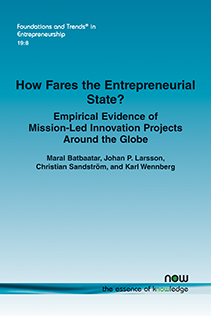How Fares the Entrepreneurial State? Empirical Evidence of Mission-Led Innovation Projects Around the Globe
By Maral Batbaatar, Stockholm School of Economics and Ratio, Sweden, maralbb34@gmail.com | Johan P. Larsson, Department of Land Economy, University of Cambridge, UK, and Ratio, Sweden, jpl66@cam.ac.uk | Christian Sandström, Jönköping International Business School and Ratio, Sweden, christian.sandstrom@ju.se | Karl Wennberg, House of Government and Public Policy (GaPP), Stockholm School of Economics, and Ratio, Sweden, karl.wennberg@hhs.se
Abstract
While considerable efforts have been made to conceptualize and outline the theoretical and normative logic of mission-oriented innovation policies and the role of the entrepreneurial state, there is a stark lack of empirical studies concerning how missions are designed and executed, and when they may work or do not. This monograph reviews theoretical rationales for mission-oriented innovation policy and provides an empirical overview of 30 articles which together cover 51 concluded or ongoing missions from around the world. We synthetize varieties of mission formulations, actors involved, and analyze characteristics of missions described as more or less failed or successful. Among the projects analyzed, many do not fulfill common definitions of “innovation missions.” Missions related to technological or agricultural innovations seem more often successful than broader types of missions aimed at social or ecological challenges, and challenges in the governance and evaluation of missions remain unresolved in the literature. None of the mission cases contain a cost-benefit analysis or takes opportunity cost into consideration.
How Fares the Entrepreneurial State? Empirical Evidence of Mission-Led Innovation Projects Around the Globe
While considerable efforts have been made to conceptualize and outline the theoretical and normative logic of mission-oriented innovation policies and the role of the entrepreneurial state, there is a stark lack of empirical studies concerning how missions are designed and executed, and when they may work or do not. How Fares the Entrepreneurial State? reviews theoretical rationales for mission-oriented innovation policy and provides an empirical overview of 30 articles which together cover 51 concluded or ongoing missions from around the world. The authors synthetize varieties of mission formulations, actors involved, and analyze characteristics of missions described as more or less failed or successful. Among the projects analyzed, many do not fulfill common definitions of ‘innovation missions’. Missions related to technological or agricultural innovations seem more often successful than broader types of missions aimed at social or ecological challenges, and challenges in the governance and evaluation of missions remain unresolved in the literature.
